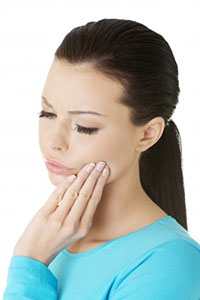 When it comes to any kind of oral discomfort, there are always many potential reasons for the pain. However, almost always, the pain can be determined as an issue with the teeth, gums, or tongue. When specified to those three, you can narrow down the possible causes of the pain.
When it comes to any kind of oral discomfort, there are always many potential reasons for the pain. However, almost always, the pain can be determined as an issue with the teeth, gums, or tongue. When specified to those three, you can narrow down the possible causes of the pain.
Toothache
When experiencing toothache your symptoms will include a sharp, throbbing, or constant pain on the tooth. There may be swelling around the tooth and bad-tasting drainage that secretes from the infected area. Toothaches are also capable of causing headaches and fevers if not properly treated.
When experience a toothache, you should visit a dentist if the pain lasts longer the 1 to 2 days, or you start to experience a fever, earache, or migraine. Of course, if the pain is excruciating, don't worry about waiting an extra day in hopes the pain will subside: immediately seek medical attention.
The most likely causes of a toothache include severe tooth decay, an abscessed tooth, a tooth fracture, or a loose or damaged filling. There may be other issues that can also occur, however, the aforementioned causes are, more likely than not, the main culprits.
When visiting the dentist for a toothache, your doctor will first consult you about your pain to help pinpoint symptoms and the location of the problem. Your dentist will ask where it hurts, what causes the pain, how and when it started, and how severe the pain is. Next your dentist will examine your mouth, gums, tongue, jaws, throat, and further depending on the symptoms you reported. Depending on the situation, the doctor may also take X-Rays of the teeth to determine the cause.
Depending on the cause, your dentist can perform several medical procedures to relive the pain. Most likely, the pain is caused from tooth decay and a cavity. Your dentist can fill the tooth, or extract the tooth if necessary. Often a root canal or crown is needed if the tooth is fractured or chipped.
Gum Problems
Gum problems such as sore, swollen, and/or bleeding gums are almost always caused by periodontal disease, also known as gum disease. More than three-quarters of Americans over the age of 35 will experience gum disease or its less severe form, gingivitis.
The cause of gum disease and swollen, sore, or bleeding gums is directly related to proper oral hygiene. Brushing, flossing, and a bacteria-killing mouthwash can all help keep your mouth clean and free of harmful bacteria.
Some of the symptoms caused by gum disease include formation of pockets between the teeth and gums where bacteria subsides, bleeding gums during or after brushing your teeth, loose teeth, bad breath, receding gums, and swollen or sore gums.
It is wise to address any of these symptoms rather quickly as the longer you wait, the more severe the disease can become. This can result is weakened teeth, inflamed gums, are serious oral issues. When bacteria grows and is over-abundant it will begin to move to your jaw line and even further into your blood stream causing severe infection.
Another common cause of sore gums comes from canker sores. These sores, or mouth ulcers, can be found inside the mouth on an area of the gums. They are a painful bump often with a white center and red edges. While the exact cause of canker sores is still undetermined, all dentists agree that they are less likely to happen with the practicing of proper oral hygiene.
Tongue Problems
Tongue issues are often much more serious than gum and teeth. The gum is often referred to as the strongest muscle in the body. So when it becomes swollen, sore, or discolored, you can potentially have a serious situation at hand. However, there are several reasonable explanations for sore tongues as well.
The simplest explanation for a sore tongue can come from accidentally biting the tongue and not knowing you did so. If the pain is in a central area and is swollen, be careful not to irritate it. If the pain subsides rather quickly, you should have nothing to worry about. If your tongue is discolored, especially with a white, filmy substance, it may just be the formation of too much plaque. In those cases, proper oral hygiene and the use of a tongue scraper (PLEASE ADD LINK), can be the solution.
More serious issues can include Lukoplakia, which causes cells in the mouth to grow rapidly and form white patches inside the mouth. Lukoplakia is often occurs after the tongue is irritated, typically when people use tobacco products. While not extremely serious, if not properly treated, leukoplakia can lead to cancer.
Another potential issue when you experience a sore or discolored tongue can be oral thrush, also known as candidiasis. This condition is a yeast infection that occurs within the mouth and creates white, lumpy patches on the surface of the tongue. Though most often seen in infants and the elderly, any person with a weakened immune system can receive this condition.
Often oral thrush happens after the use of antibiotics, which can flush out the good bacteria that rests in your mouth. Kombucha and yogurt can both help restore the bacteria in your mouth that will prevent oral thrush.
Another tongue issue that can happen often is known as Red or Strawberry tongue. The result is a normal colored tongue turning a bright red or even resembles the texture of a strawberry with enlarged bumps and dotting.
There are several reasons for red or strawberry tongue including folic acid and B-12 deficiencies, scarlet fever, and kawasaki syndrome. Benign migratory glossitis is often the most common cause, which causes a map-like pattern of red spots on the surface of the tongue. Because of such, it is often referred to as geographic tongue. This is a harmless condition, which usually last no longer than 2 weeks. It is wise to consult a dentist however so they can detect for certain that it is benign migratory glossitis. If so, your dentist may recommend a topical medication to help with any discomfort.
Black Hairy Tongue can occur when the small bumps on the surface of your tongue known as papillae become excessively long. A typically mouth will wear down papillae through its lifetime while patients with black hairy tongue will see an increase in size over time. This makes your tongue more likely to contract infection from harboring bacteria. If bacteria begin to grow the papillae will become darker and resemble hair. Though this is mostly a harmless condition, proper oral hygiene is encouraged to keep the issue at bay.
For all conditions including teeth, gum, and tongues, the best method of defense is proper oral hygiene. Brush your teeth two to three times daily, floss once a day, and employ a tongue scraped and mouthwash when needed. Avoid smoking and excessive alcohol. Eat a proper diet that includes a high amount of fruits and vegetables. And, as always, visit a dentist twice a year for cleaning and inspection.
If you have any more questions on the causes of pain on the teeth, gums, and tongue, contact Water Tower Dental. We can direct you toward the rights steps for care and help set up an appointment to see one of our expert dentists.
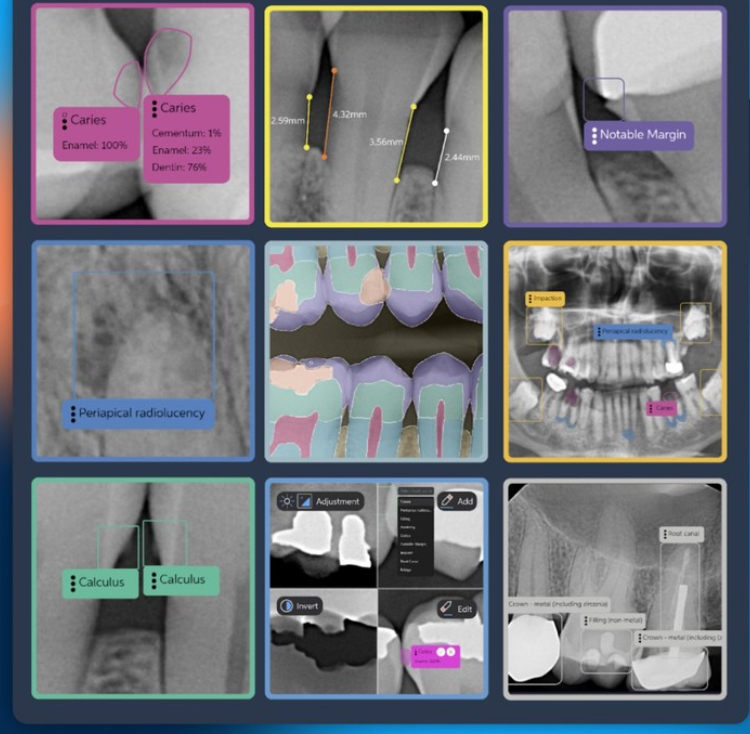

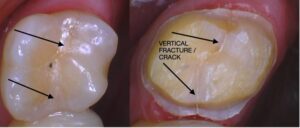
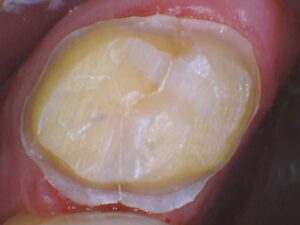
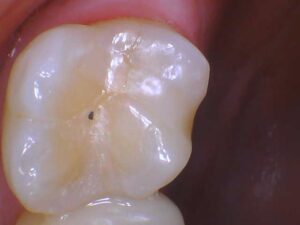
 There are many ways to brush teeth, but some are much more effective than others. Using a Sonicare Electric Toothbrush, the number one brand recommended by dental professionals, delivers a superior clean for a healthier mouth. For optimal results, even this advanced toothbrush needs to be used properly.
There are many ways to brush teeth, but some are much more effective than others. Using a Sonicare Electric Toothbrush, the number one brand recommended by dental professionals, delivers a superior clean for a healthier mouth. For optimal results, even this advanced toothbrush needs to be used properly. Have you experienced a tight jaw, impressions on your tongue or a tooth that seemed loose, chipped, or fractured? What about sore facial muscles, increased sensitivity in your teeth, or a partner that complains about clicking noises you make with your mouth? If you said yes to all or most of these, you could be a teeth grinder. Read on to find out why teeth grinding is harmful, what causes it, and what you can do to stop grinding and clenching your teeth during the day.
Have you experienced a tight jaw, impressions on your tongue or a tooth that seemed loose, chipped, or fractured? What about sore facial muscles, increased sensitivity in your teeth, or a partner that complains about clicking noises you make with your mouth? If you said yes to all or most of these, you could be a teeth grinder. Read on to find out why teeth grinding is harmful, what causes it, and what you can do to stop grinding and clenching your teeth during the day. When you’re fast asleep, the last thing you’re thinking about is your teeth. (Unless you’re having a dental dream, of course.) So it’s important to make sure that your teeth are well protected before you hit the hay for a long night of sleep. We’ve put together a short checklist that you can use every night before you go to bed to keep your teeth protected all night long.
When you’re fast asleep, the last thing you’re thinking about is your teeth. (Unless you’re having a dental dream, of course.) So it’s important to make sure that your teeth are well protected before you hit the hay for a long night of sleep. We’ve put together a short checklist that you can use every night before you go to bed to keep your teeth protected all night long. You can’t always put off seeing the dentist. If you have a simple cavity, it’s easy to wait to see the dentist for a couple of days. A painful cracked tooth is another story. We’re here to help you figure out what you should do if you have a dental emergency in Chicago. The more prepared you are, the quicker you’ll be able to deal with any serious dental issues.
You can’t always put off seeing the dentist. If you have a simple cavity, it’s easy to wait to see the dentist for a couple of days. A painful cracked tooth is another story. We’re here to help you figure out what you should do if you have a dental emergency in Chicago. The more prepared you are, the quicker you’ll be able to deal with any serious dental issues. Whether you’ve lost your front teeth due to an injury or an oral disease,
Whether you’ve lost your front teeth due to an injury or an oral disease, 
 Dentists have come a long way in the realm of
Dentists have come a long way in the realm of  When it comes to your teeth, you should never have to wait to get an important cosmetic or general dentistry treatment done just because of money. That’s why we offer a variety of payment options at Water Tower Dental Care in Chicago. This way, you can receive affordable dental care when you need it most. We’re going to break down some of our payment options now so that you know exactly what to expect when you come into our Chicago office.
When it comes to your teeth, you should never have to wait to get an important cosmetic or general dentistry treatment done just because of money. That’s why we offer a variety of payment options at Water Tower Dental Care in Chicago. This way, you can receive affordable dental care when you need it most. We’re going to break down some of our payment options now so that you know exactly what to expect when you come into our Chicago office. While people usually focus on keeping their teeth pearly white, your gums should not be overlooked. Even if your teeth are as healthy as they can be, your gums may not be free from disease. As gum disease is usually painless, it often goes unnoticed. Gum disease, however, is treatable and the damage can fortunately be reversed. Learn more about gum disease and treatments at home to prevent your gums from looking like
While people usually focus on keeping their teeth pearly white, your gums should not be overlooked. Even if your teeth are as healthy as they can be, your gums may not be free from disease. As gum disease is usually painless, it often goes unnoticed. Gum disease, however, is treatable and the damage can fortunately be reversed. Learn more about gum disease and treatments at home to prevent your gums from looking like  Everyone hates teeth discoloration, which is why whitening strips are so popular. But what do you do when the discoloration appears in the form of white spots on your teeth? Although these spots are primarily a cosmetic concern, they can affect oral health and should be treated.
Everyone hates teeth discoloration, which is why whitening strips are so popular. But what do you do when the discoloration appears in the form of white spots on your teeth? Although these spots are primarily a cosmetic concern, they can affect oral health and should be treated.
 The last thing you want is yellow teeth after years of wearing braces. But unfortunately, it’s a very common occurrence. If you don’t take care of your mouth while you’re wearing braces, you might be surprised to see white squares where your braces were on yellow-stained teeth after your dentist removes them. Thankfully, it’s easy to avoid this experience. Here are some reasons why people get yellow teeth after braces and how to prevent this from happening. We’ll also talk about how you can fix stained teeth after braces.
The last thing you want is yellow teeth after years of wearing braces. But unfortunately, it’s a very common occurrence. If you don’t take care of your mouth while you’re wearing braces, you might be surprised to see white squares where your braces were on yellow-stained teeth after your dentist removes them. Thankfully, it’s easy to avoid this experience. Here are some reasons why people get yellow teeth after braces and how to prevent this from happening. We’ll also talk about how you can fix stained teeth after braces. Just because you have a particularly hungry sweet tooth doesn’t mean you're doomed to have cavities. There are a handful of sugar and sweetener alternatives out there that aren’t bad for your teeth. In fact, some of these sweet substitutes have actually been found to be good for your teeth. We’re here to let you know which sugar alternatives and sweeteners are best for your teeth.
Just because you have a particularly hungry sweet tooth doesn’t mean you're doomed to have cavities. There are a handful of sugar and sweetener alternatives out there that aren’t bad for your teeth. In fact, some of these sweet substitutes have actually been found to be good for your teeth. We’re here to let you know which sugar alternatives and sweeteners are best for your teeth. Having an underbite is no fun. Not only does can it look strange, but it may also cause serious health issues. Back in the day, the only way to fix underbites was with surgery, braces or expanders. Thankfully, there are less invasive and revealing ways to deal with underbites nowadays. We’re here to tell you how
Having an underbite is no fun. Not only does can it look strange, but it may also cause serious health issues. Back in the day, the only way to fix underbites was with surgery, braces or expanders. Thankfully, there are less invasive and revealing ways to deal with underbites nowadays. We’re here to tell you how 
 There’s a reason
There’s a reason  Balancing work, friends, family, hobbies and relaxation time is hard enough. Trying to find the time to squeeze in a dentist appointment to fix your broken tooth before it gets worse may seem impossible. You need to fix your broken tooth before your nerves are exposed to dangerous bacteria that can cause serious infection, but you can’t seem to find the time to get around to making multiple visits to the dentist. That’s where CEREC One-Visit Crowns come in.
Balancing work, friends, family, hobbies and relaxation time is hard enough. Trying to find the time to squeeze in a dentist appointment to fix your broken tooth before it gets worse may seem impossible. You need to fix your broken tooth before your nerves are exposed to dangerous bacteria that can cause serious infection, but you can’t seem to find the time to get around to making multiple visits to the dentist. That’s where CEREC One-Visit Crowns come in. 
 A smile says a lot about you. A sparkling and straight grin will tell people that you take the time to take care of yourself and your teeth, and can give you a serious confidence boost. Unfortunately, not all of us have the teeth we wish we had. Genetics and accidents can leave us with chipped, stained or crooked teeth that we’re unhappy with. But there’s a solution. Dental veneers can cover up your dental imperfections in a quick and efficient way for years to come.
A smile says a lot about you. A sparkling and straight grin will tell people that you take the time to take care of yourself and your teeth, and can give you a serious confidence boost. Unfortunately, not all of us have the teeth we wish we had. Genetics and accidents can leave us with chipped, stained or crooked teeth that we’re unhappy with. But there’s a solution. Dental veneers can cover up your dental imperfections in a quick and efficient way for years to come.

 Have you ever noticed how much you clench your teeth during a difficult workout? Though exercising is great for your body, it can ruin your teeth if you’re not careful. We’ve come up with a few easy tips to help you protect your teeth while you’re exercising. This way, you can make your workouts healthy for every part of your body!
Have you ever noticed how much you clench your teeth during a difficult workout? Though exercising is great for your body, it can ruin your teeth if you’re not careful. We’ve come up with a few easy tips to help you protect your teeth while you’re exercising. This way, you can make your workouts healthy for every part of your body! Nobody likes having crooked teeth. They don’t give you the most beautiful smile in the world and they’re hard to take care of. Ironically, nobody really likes wearing braces to straighten their crooked teeth either, for pretty much the same reasons. At Water Tower Dental Care, we have a better solution to straighten your smile: Invisalign.
Nobody likes having crooked teeth. They don’t give you the most beautiful smile in the world and they’re hard to take care of. Ironically, nobody really likes wearing braces to straighten their crooked teeth either, for pretty much the same reasons. At Water Tower Dental Care, we have a better solution to straighten your smile: Invisalign. 
 Many people who wear braces are worried about keeping their teeth white. After all, cleaning your teeth is much more difficult with braces, and you can’t really use teeth-whitening products on the part of your teeth that’s covered up. What you can do, though, is prevent your teeth from discoloring. Find out how to do this with these 11 easy tips from our dental experts.
Many people who wear braces are worried about keeping their teeth white. After all, cleaning your teeth is much more difficult with braces, and you can’t really use teeth-whitening products on the part of your teeth that’s covered up. What you can do, though, is prevent your teeth from discoloring. Find out how to do this with these 11 easy tips from our dental experts. For the young and old, teeth grinding is a serious concern. Thankfully there are methods to stopping teeth grinding before it gets too serious. For the young, however, this can be harder to do than for an adult. Children have less of a conscious attitude toward health than an adult, who understands the cause and effect of such bad habits. For children, it will take the help of their parent to stop teeth grinding before it becomes a serious health concern.
For the young and old, teeth grinding is a serious concern. Thankfully there are methods to stopping teeth grinding before it gets too serious. For the young, however, this can be harder to do than for an adult. Children have less of a conscious attitude toward health than an adult, who understands the cause and effect of such bad habits. For children, it will take the help of their parent to stop teeth grinding before it becomes a serious health concern.
 Did you know that when you smile while talking on the phone, the person on the other end can tell and will respond positively? It’s true. It seems wild that someone might be able to tell if you’re smiling over the phone, but is it really that far-fetched? Think of how many times you’ve answered the phone in a bad or angry mood. The other person on the other end will almost immediately ask you what’s wrong. So why wouldn’t they be able to tell when you’re in a good mood?
Did you know that when you smile while talking on the phone, the person on the other end can tell and will respond positively? It’s true. It seems wild that someone might be able to tell if you’re smiling over the phone, but is it really that far-fetched? Think of how many times you’ve answered the phone in a bad or angry mood. The other person on the other end will almost immediately ask you what’s wrong. So why wouldn’t they be able to tell when you’re in a good mood? There is a lot to say about a smile that communicates your emotions precisely. It doesn’t always mean happy, either. A smile can communicate mischief, fear, doubt, surprise, and many other emotions. So how do you know if your smile is delivering the right message? First, you must find your perfect smile: the natural way you smile that makes you feel confident you’re communicating the right message. Here are our tips to getting that perfect smile.
There is a lot to say about a smile that communicates your emotions precisely. It doesn’t always mean happy, either. A smile can communicate mischief, fear, doubt, surprise, and many other emotions. So how do you know if your smile is delivering the right message? First, you must find your perfect smile: the natural way you smile that makes you feel confident you’re communicating the right message. Here are our tips to getting that perfect smile.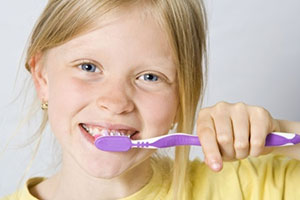 Do you have trouble convincing your children it’s time to brush their teeth? Many kids find it difficult to want to scrub their tiny molars as they see it just like any other chore. However, with the right attitude you can make brushing teeth a fun activity that your children get excited to do. Healthy teeth in young children are extremely important, so try out a few of these tips next time you’re brushing with your kids.
Do you have trouble convincing your children it’s time to brush their teeth? Many kids find it difficult to want to scrub their tiny molars as they see it just like any other chore. However, with the right attitude you can make brushing teeth a fun activity that your children get excited to do. Healthy teeth in young children are extremely important, so try out a few of these tips next time you’re brushing with your kids.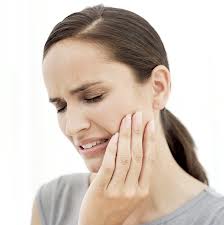 Clenching and grinding your teeth is a harmful and unhealthy habit to form. Unfortunately most people don’t even know they do it. Most teeth grinders do so in their sleep so they have no idea it’s happening. The result of clenching and grinding can cause serious damage to your teeth along with other symptoms. We’d like to show you how to stop grinding your teeth.
Clenching and grinding your teeth is a harmful and unhealthy habit to form. Unfortunately most people don’t even know they do it. Most teeth grinders do so in their sleep so they have no idea it’s happening. The result of clenching and grinding can cause serious damage to your teeth along with other symptoms. We’d like to show you how to stop grinding your teeth.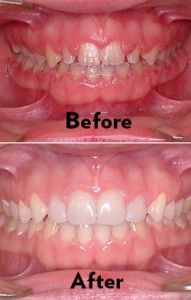 When a patient has an excessive amount of gum tissue covering their teeth, they can option for a procedure known as laser gum recontouring, or more commonly referred to as laser gum lifts. This simple procedure can transform a person’s mouth and give them a more confident smile. So what are laser gum lifts and how is the procedure performed?
When a patient has an excessive amount of gum tissue covering their teeth, they can option for a procedure known as laser gum recontouring, or more commonly referred to as laser gum lifts. This simple procedure can transform a person’s mouth and give them a more confident smile. So what are laser gum lifts and how is the procedure performed?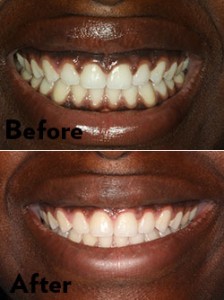 For patients that would like to have less build up of gums and a better looking smile, laser gum lifts are a great option. At Water Tower Dental, we can help reshape your gum line to lengthen your teeth, and eliminate a surplus of gums that distract someone from seeing your brilliant smile. As well, some patients don’t necessarily have a surplus of gums but rather an uneven gum line. When that happens, we are able to create a symmetrical gum line that keeps your teeth looking even and allows for your smile to shine.
For patients that would like to have less build up of gums and a better looking smile, laser gum lifts are a great option. At Water Tower Dental, we can help reshape your gum line to lengthen your teeth, and eliminate a surplus of gums that distract someone from seeing your brilliant smile. As well, some patients don’t necessarily have a surplus of gums but rather an uneven gum line. When that happens, we are able to create a symmetrical gum line that keeps your teeth looking even and allows for your smile to shine.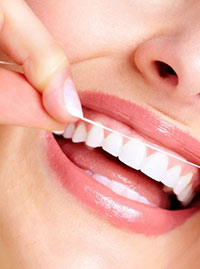 Over half of American adults have had or currently suffer from periodontal disease, also known as gum disease. There are many ways, however, that you can rebuild your gums including proper oral care and eating the right kinds of foods.
Over half of American adults have had or currently suffer from periodontal disease, also known as gum disease. There are many ways, however, that you can rebuild your gums including proper oral care and eating the right kinds of foods. When it comes to any kind of oral discomfort, there are always many potential reasons for the pain. However, almost always, the pain can be determined as an issue with the teeth, gums, or tongue. When specified to those three, you can narrow down the possible causes of the pain.
When it comes to any kind of oral discomfort, there are always many potential reasons for the pain. However, almost always, the pain can be determined as an issue with the teeth, gums, or tongue. When specified to those three, you can narrow down the possible causes of the pain.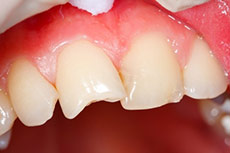 Whether you took a bite into something too hard for your tooth, or took a nasty spill, the potential to crack, fracture or chip your tooth is possible. Thankfully, there are several ways to fix a chipped tooth depending on the severity of the accident.
Whether you took a bite into something too hard for your tooth, or took a nasty spill, the potential to crack, fracture or chip your tooth is possible. Thankfully, there are several ways to fix a chipped tooth depending on the severity of the accident.
 Water Tower Dental Care recommends Invisalign for adults with crooked teeth. Unlike regular, metal braces, Invisalign are practically invisible to the human eye. These clear braces are made through a 3D modeling process that fits specifically to your teeth, each set slightly straighter than the previous ones.
Water Tower Dental Care recommends Invisalign for adults with crooked teeth. Unlike regular, metal braces, Invisalign are practically invisible to the human eye. These clear braces are made through a 3D modeling process that fits specifically to your teeth, each set slightly straighter than the previous ones.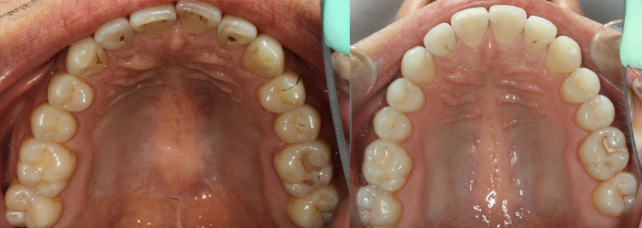
 Invisalign Food Restrictions
Invisalign Food Restrictions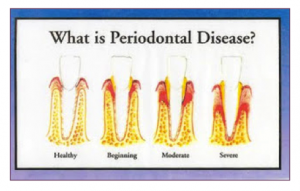 To keep a healthy smile, one must focus on the gums just as much as their teeth. Without proper care, gums can harbor many harmful types of bacteria that can result in gum disease. We already listed the best ways for
To keep a healthy smile, one must focus on the gums just as much as their teeth. Without proper care, gums can harbor many harmful types of bacteria that can result in gum disease. We already listed the best ways for 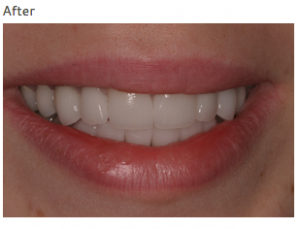 Many patients think that the longer they wait to come to the dentist, the closer they get to un-repairable teeth. Though untreated dental conditions can rapidly affect the health and appearance of your teeth, our team at Water Tower Dental Care can always do something to help. More likely than not, a
Many patients think that the longer they wait to come to the dentist, the closer they get to un-repairable teeth. Though untreated dental conditions can rapidly affect the health and appearance of your teeth, our team at Water Tower Dental Care can always do something to help. More likely than not, a 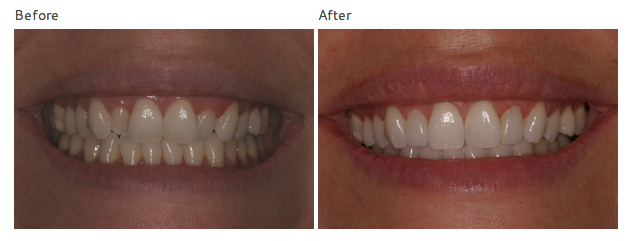
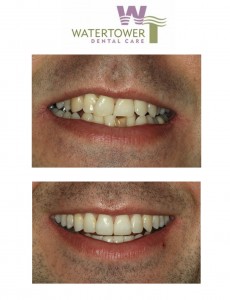 These amazing treatment results are from Invisalign and one veneer by Dr. Daniel Aneszko at Water Tower Dental Care. Call our office at 312-787-2131 to schedule a complimentary cosmetic consult to discuss treatment options for YOU!!!
These amazing treatment results are from Invisalign and one veneer by Dr. Daniel Aneszko at Water Tower Dental Care. Call our office at 312-787-2131 to schedule a complimentary cosmetic consult to discuss treatment options for YOU!!!




 Website Powered by Sesame 24-7™
Website Powered by Sesame 24-7™